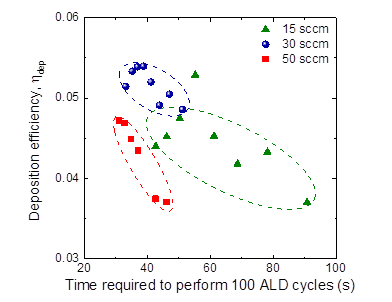
-
- au
Ici vous trouverez le papier de Viet et Abdou
"Being able to control the exposure of precursors to the substrate surface is essential towards an optimum Atomic Layer Deposition (ALD) process. Conventional ALD usually requires large excesses of precursors and expensive vacuum chamber in which the precursor exposure can be controlled via the injection pulse duration followed by a delay time. A version of ALD, namely Spatial ALD (SALD), which has the same unique assets as conventional ALD but being faster, vacuum-free, and easier to scale up, has recently attracted much attention. In SALD, precursors are continuously exposed to a moving surface, and thus it is more complicated to tune precursor exposure than with conventional ALD. Here, we present a study on how to control this critical parameter in for the deposition of ZnO films using a close-proximity, open-air SALD. Our results are based on both simulations and experiments. A simple physical model supported by Comsol Multiphysics simulations has been developed to study the effect of the substrate velocity as well as the precursor concentration in the carrier gas on film growth rate. We found that the precursor entrainment by the moving substrate induces an asymmetric precursor concentration profile that affects the obtained GPC. Also, we show that the mass density and structural properties of the deposited films depend closely on the film growth rate. For instance, fast growth does not always produce dense films. Indeed, a compromise between the growth rate and the precursor consumption should be considered to obtain both good process efficiency and high-quality films. Our findings are particularly relevant for using SALD in large-scale coating applications, in which high deposition rate and good coating density should be obtained with a minimal ALD precursor consumption."


